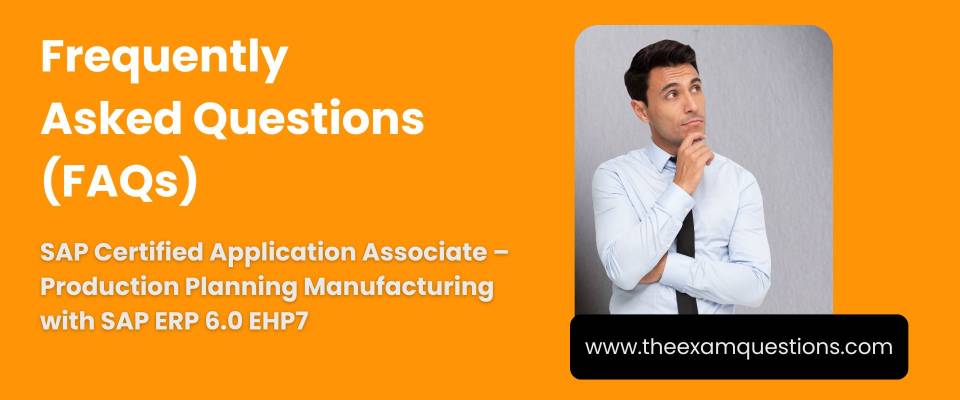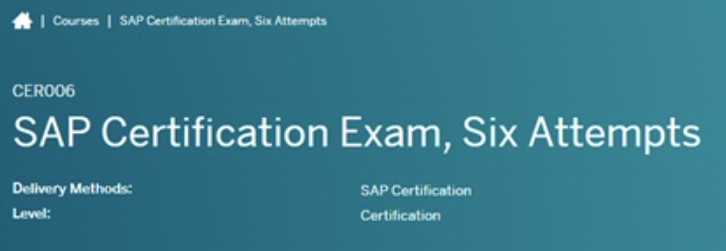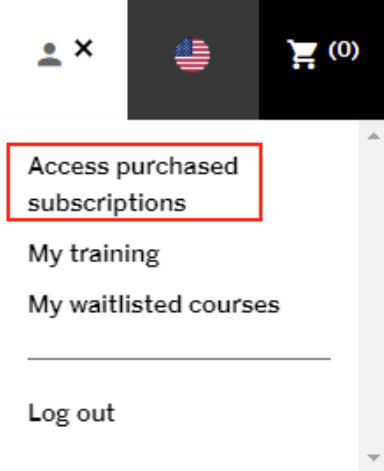FAQ - SAP Certified Application Associate – Production Planning Manufacturing with SAP ERP 6.0 EHP7

Here we are listing all SAP Certified Application Associate ? Production Planning Manufacturing with SAP ERP 6.0 EHP7 Frequently Asked Questions. These are mostly asked when appearing for Production Planning Manufacturing with SAP ERP 6.0 EHP7 Exam. Once you go through it, this will help you to better prepare for exam.
What are the total questions for the C_TSCM42_67 exam?
80 questions
What is the cost of C_TSCM42_67 exam or Production Planning Manufacturing with SAP ERP 6.0 EHP7 certification fees?
200 USD if you purchase CER001 (1 attempt) and 500 USD if you purchase CER006 (6 attempts).
What is the passing percentage for Production Planning Manufacturing with SAP ERP 6.0 EHP7 exam?
63 Percentage
What is the duration of exam C_TSCM42_67?
180 mins
What are the topics covered in exam C_TSCM42_67?
- Material and Capacity Requirements Planning, (> 12%) => Characterize production-relevant planning functionality.
- Material Requirements Planning (PP-MRP), (> 12%) => Explore material requirements planning functions.
- Production Orders Advanced (PP-SFC), (> 12%) => Configure production order functionality.
- Lean Manufacturing (PP-REM, PP-KAB), (8% - 12%) => Outline the highlights of repetitive manufacturing and kanban.
- Master Data (LDM), (8% - 12%) => Set up master data for production planning and manufacturing.
- Production Orders Basics (PP-SFC), (8% - 12%) => Apply production order functionality.
- Application Overview and Background, ( 8%) => Characterize the interplay of master data, planning, ATP, and production functionality.
- Basics on SAP Business Processes (E-Learnings), ( 8%) => Outline the scope of SAP SCM business processes.
- Process Orders (PP-PI), ( 8%) => Identify specific properties of process orders.
What books needs to be read for exam C_TSCM42_67?
- SAP Learning hub PLM114 - Basic Data for Manufacturing and Product Management pdf
- SAP Learning hub SCM130 - SAP ERP Planning and Manufacturing Overview pdf
- SAP Learning hub SCM240 - Production Planning in ERP pdf
- SAP Learning hub SCM365 - Capacity Evaluation & Leveling in ECC pdf
- SAP Learning hub SCM300 - Manufacturing Overview pdf
- SAP Learning hub SCM310 - Production Orders pdf
- SAP Learning hub TSCM40 - SAP ERP Planning/Manufacturing I - Academy pdf
- SAP Learning hub TSCM42 - SAP ERP Planning/Manufacturing II - Academy pdf
Where to get Study Material and books for C_TSCM42_67?
You can check here Production Planning Manufacturing with SAP ERP 6.0 EHP7 books.
In how many languages C_TSCM42_67 exam available?
German, English, Japanese
What is the level of Production Planning Manufacturing with SAP ERP 6.0 EHP7 exam?
Associate
What is the process to register C_TSCM42_67 exam?
- Go to training.sap.com and register with your E-Mail id.
- Confirm your email address and finish the registration.
- If you are planning to take only this exam, then you need to buy for Single attempt subscription which is CER001. CER001 giver 12 months period in which you can schedule the C_TSCM42_67 exam.

- Search for product CER001 on SAP website and add it to cart and do the checkout.
- If you are planning to do multiple SAP certifications, then you should consider buying CER006 product. CER006 also gives 12 months period in which you can schedule maximum 6 exams.

- Once you have purchased either CER001 or CER006, you will get access to SAP certification hub.
- Click on your profile icon and select ?Access purchased Subscriptions? as shown below:

- Go to SAP certification hub. click on ?Exam Dashboard?. Next, click on ?Schedule an exam? and you are good to go.

- Successful completion will make you receive an SAP Certification digital badge for your accomplishment.
How is the exam conducted?
SAP C_TSCM42_67 Certification exam is remotely proctored via a webcam on your PC or laptop, and you can schedule your exam 24/7 via Certification Hub.
Do I need to go someplace to take the C_TSCM42_67 exam?
No, exams are available online 24/7 and each exam is proctored remotely. You can take exams anywhere in the world as long as you have an Internet connection and a laptop or desktop computer with a webcam.
Do I need to be alone to take exam?
Yes, phone should also be switched off. Your exam supervisor or examiner will ask you to rotate your webcam around the room prior to beginning your SAP Certification exam. Please ensure the area contains only permitted items approved by your exam supervisor. Whiteboards and bulletin boards must be cleared, erased, or covered, unless they are facing away from you. All cell phones, tablets, and other communication or recording devices must be removed from the computer area.
Can I take SAP C_TSCM42_67 Certification exam on a tablet computer?
No, tablets are not supported.
What do I receive after successful completion of exam?
Successful examinees receive an SAP Certification digital badge for their accomplishment.
What is the benefit of taking the exam?
- Gain a highly recognized accreditation of excellence.
- Differentiate yourself in the labour market.
- Validate your skills to execute with confidence.
- Possibility to attain higher wages and billable rates with a highly valued credential.
Can I retake for Production Planning Manufacturing with SAP ERP 6.0 EHP7 exam, if fail?
You can attempt C_TSCM42_67 exam 2 more times. If in worst case, you still could not clear the exam after 2 times, then you will have to wait for next version of exam to arrive.
How can I get the practice questions for exam C_TSCM42_67?
Practice questions are very important to understand the pattern of exam. You can check C_TSCM42_67 practice questions here.
What topics are covered in Book SCM240 (Production Planning in ERP)?
- Overview of Production Planning in SAP ERP
- Outlining the Supply Chain Planning Process
- Outlining the Core Production Planning Process
- Demand Management
- Outlining Demand Management
- Planning Make-to-Stock Production Without Consumption Logic
- Planning Make-to-Stock Production with Consumption Logic
- Planning Make-to-Order Production Without Consumption Logic
- Planning Make-to-Order Production with Consumption Logic
- Using Assembly Processing in Make-to-Order Production
- Applying Demand Management Enhancements
- Analyzing Availability Checks
- Material Requirements Planning Execution
- Outlining Material Requirements Planning
- Setting Up the MRP Prerequisites
- Executing the MRP Run
- Setting Up the MRP Run
- Planning MRP Interactively
- Applying Firming Mechanisms
- Technical Processes of Requirements Planning
- Calculating Net Requirements
- Applying Buffers in Net Requirements Calculation
- Calculating Lot Sizes
- Selecting Procurement Types
- Setting Up Basic-Date Scheduling
- Setting Up Lead-Time Scheduling
- Selecting BOM and Routing
- MRP Results Processing and Evaluations
- Comparing an MRP List and a Stock/Requirements List
- Applying the Planning Table
- Identifying Exception Messages
- Applying Additional Evaluation Aids
- Additional MRP Processes
- Applying Master Production Scheduling (MPS)
- Setting Up Long-Term Planning
- Executing Long-Term Planning
- Analyzing Multi-Site Planning
- Setting Up MRP Areas
- Applying MRP Areas
What topics are covered in Book SCM365 (Capacity Evaluation & Leveling in ECC)?
- Evaluation of capacity loads using reports in ECC
- Evaluation of capacity loads using reports using BI
- Navigational Skills of Tabular and Graphical Planning tables
- Detailed understanding of Capacity Leveling functionality (Strategy Profile)
- Modeling Down time Scenarios
What topics are covered in Book TSCM40 (SAP ERP Planning/Manufacturing I - Academy)?
- Creating and managing master data:
- Material master
- BOM
- Classes and characteristics
- Documents
- Overview of variant configuration
- Work centers and routings
- Production resources
- Changes with and without history, and mass change processing
- ERP production planning:
- Demand management
- Planning-based MRP
- Planning strategies for make-to-stock and make-to-order production
- Implementing requirements planning
- Processing of MRP results and additional MRP processes
What topics are covered in Book SCM310 (Production Orders)?
- Introduction to Production Orders
- Outlining SAP Supply Chain Management
- Outlining Production Orders
- Applying Production Orders in Supply Chain Management
- Order Processing and Order Structure
- Processing Production Orders
- Analyzing the Production Order Structure
- Order Creation
- Creating Production Orders Without Master Data
- Creating Production Orders Based on Planned Orders
- Creating Production Orders Without Planned Orders
- Defining Order Types
- Creating Production Orders with Master Data
- Scheduling Production Orders
- Costing of Production Orders
- Order Release
- Checking Material Availability
- Checking Capacity Availability
- Checking Production Resource/Tool Availability
- Planning Capacities
- Releasing Production Orders
- Order Documents
- Setting Up Order Print Control
- Printing Production Orders
- Material Staging
- Staging Material
- Withdrawing Material
- Confirmations
- Setting Parameters for Confirmations
- Executing Confirmations
- Goods Receipt
- Preparing Goods Receipts
- Posting Goods Receipts
- Order Settlement, Archiving, and Deletion
- Settling Production Orders
- Archiving and Deleting Production Orders
- Information Systems and Automation
- Applying Information Systems
- Automating Production Orders and Mass Processing
- Applying Collective Orders
- Applying Trigger Points
- Extended Functionality and Enhancements
- Applying Order Split
- Applying Shift Reports and Shift Notes
- Applying Work-in-Process (WIP) Batches
- Applying SAP Execution Steps (XSteps) for Routings and Production Orders
- Outlining the Production Planning-Plant Data Collection (PP-PDC) Interface
- Outlining SAP Manufacturing Integration and Intelligence (SAP MII) in Shop Floor Control
- Applying Handling Units in Production
What topics are covered in Book SCM300 (Manufacturing Overview)?
- Production Execution Overview
- Distinguishing Production Types
- Production Order Processing
- Outlining Production Orders
- Creating Production Orders
- Releasing Production Orders
- Executing Material Staging for Production Orders
- Executing Confirmation and Goods Receipt for Production Orders
- Evaluating Production Orders
- Process Order Processing
- Outlining Process Orders
- Creating and Interpreting Process Orders
- Executing Process Orders
- Using Additional Functions with Process Orders
- Repetitive Manufacturing Processing
- Outlining Repetitive Manufacturing
- Preparing Repetitive Manufacturing
- Planning Line Loading in Repetitive Manufacturing
- Using Material Staging and Confirmation
- Integrating Costing, Controlling, and Reporting
- Kanban Principles in Production
- Outlining Kanban
- Using Kanban in Production
What topics are covered in Book SCM130 (SAP ERP Planning and Manufacturing Overview)?
- Introduction to Supply Chain Planning
- Drafting Supply Chain Planning
- Planning-Specific Master Data
- Reviewing Supply Chain Master Data
- Reviewing Production Master Data
- Sales and Operations Planning
- Drafting Flexible Planning
- Executing Standard Sales and Operations Planning
- Releasing a Standard Sales and Operations Plan
- Demand Management
- Setting Up a Demand Program
- Planning Make-to-Stock Production
- Planning Make-to-Order Production
- Checking Product Availability
- Material Requirements Planning
- Drafting MRP Procedures
- Planning Material Requirements
- Interpreting the Results of Material Requirements Planning
- Long-Term Planning
- Creating a Long-Term Planning Scenario
- Executing Long-Term Planning
- Introduction to Production Execution
- Distinguishing Production Types
- Production with Production Orders
- Drafting Production Orders
- Creating Production Orders
- Releasing Production Orders
- Executing Material Staging for Production Orders
- Executing Confirmation and Goods Receipt for Production Orders
- Evaluating Production Orders
- Production with Process Orders
- Drafting Process Orders
- Creating and Interpreting Process Orders
- Executing Process Orders
- Using Additional Functions with Process Orders
- Repetitive Manufacturing
- Drafting Repetitive Manufacturing
- Preparing Repetitive Manufacturing
- Planning Line Loading in Repetitive Manufacturing
- Using Material Staging and Confirmation
- Integrating Costing, Controlling, and Reporting
- The Kanban Principle
- Drafting Kanban
- Using Kanban in Production
What topics are covered in Book PLM114 (Basic Data for Manufacturing and Product Management)?
- Accessing and Creating Types of Data
- Using Organizational Elements and Master Data in Production
- Creating a Plant in SAP ERP
- Creating a Storage Location in SAP ERP
- Creating MRP Areas
- Describing the Structure of the Material Master Record
- Maintaining Prerequisites for Creating Material Masters
- Creating a Material Master Record
- Classifying Material Master Records
- Managing the Material Master
- Describing the Structure of the Bill Of Material
- Managing the Validity of BOMs
- Managing Bills of Material
- Using ECM to Change BOMs
- Analyzing Bills of Material
- Configuring Bills of Material
- Describing the Structure of Master Data
- Creating Work Centers
- Creating Capacities in the Work Center
- Integrating Costing with the Work Center
- Describing the Structure of the Task List
- Creating Material Assignments and Component Allocations
- Creating Suboperations and User-Defined Fields
- Analyzing and Changing Task Lists
- Describing Phantom Assemblies
- Creating Co-Products and By-Products
- Creating Alternative Components
- Creating Multiple BOMs
- Creating Variant BOMs
- Using Mass Change and the Product Structure Browser
- Modeling Complex and Flexible Manufacturing
- Modeling Alternative Manufacturing Processes
- Creating Reference Operation Sets
- Using Lead-Time Scheduling to Update the Material Master
- Scheduling Time Elements and Reduction in the Routing
- Creating Trigger Points
- Using Scrap in the Routing
- Creating Production Resources and Tools
- Describing the Structure of the Engineering Workbench
- Setting the Work Area, Selection Criteria, and Effectivity Window
- Navigating in the Engineering Workbench
- Creating Engineering Workbench Work Areas
- Using the PLM Web User Interface
- Using Status and Action Management
- Synchronizing BOMs using Guided Structure Synchronization
- Tracking Changes in BOMs Using Redlining
How to get Production Planning Manufacturing with SAP ERP 6.0 EHP7 certification dumps?
Check it out here: C_TSCM42_67 certification dumps
Tags:
C_TSCM42_67 FAQ | C_TSCM42_67 detail | C_TSCM42_67 study material | C_TSCM42_67 practice tests | C_TSCM42_67 sample questions | C_TSCM42_67 Pdf dumps